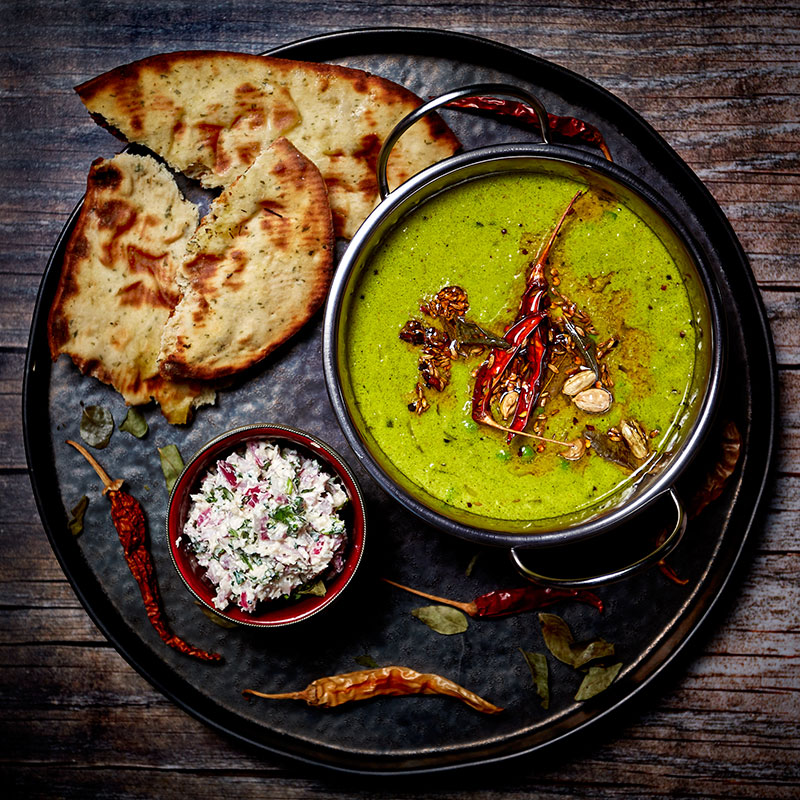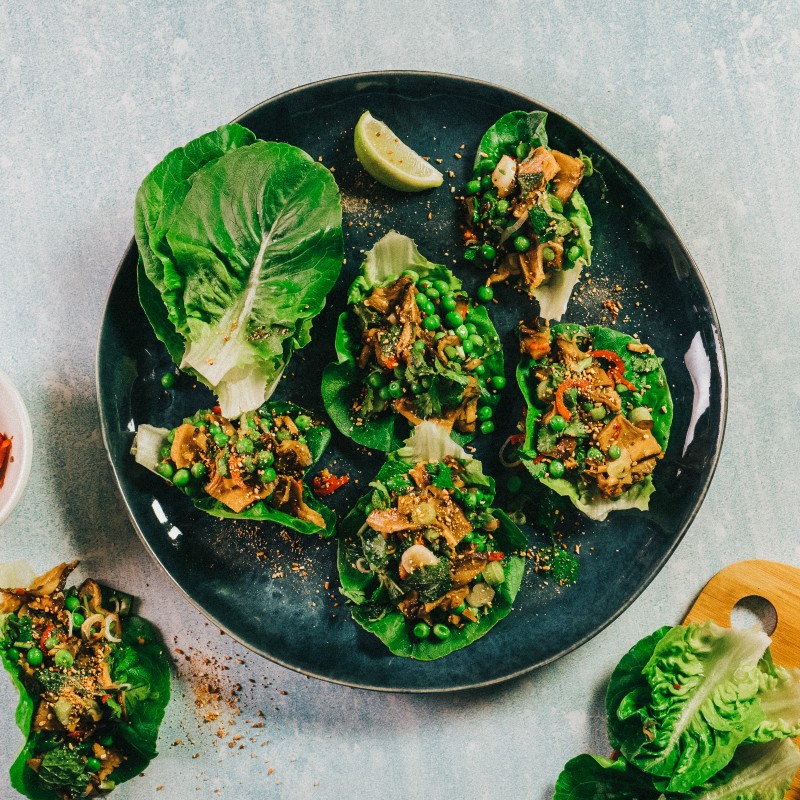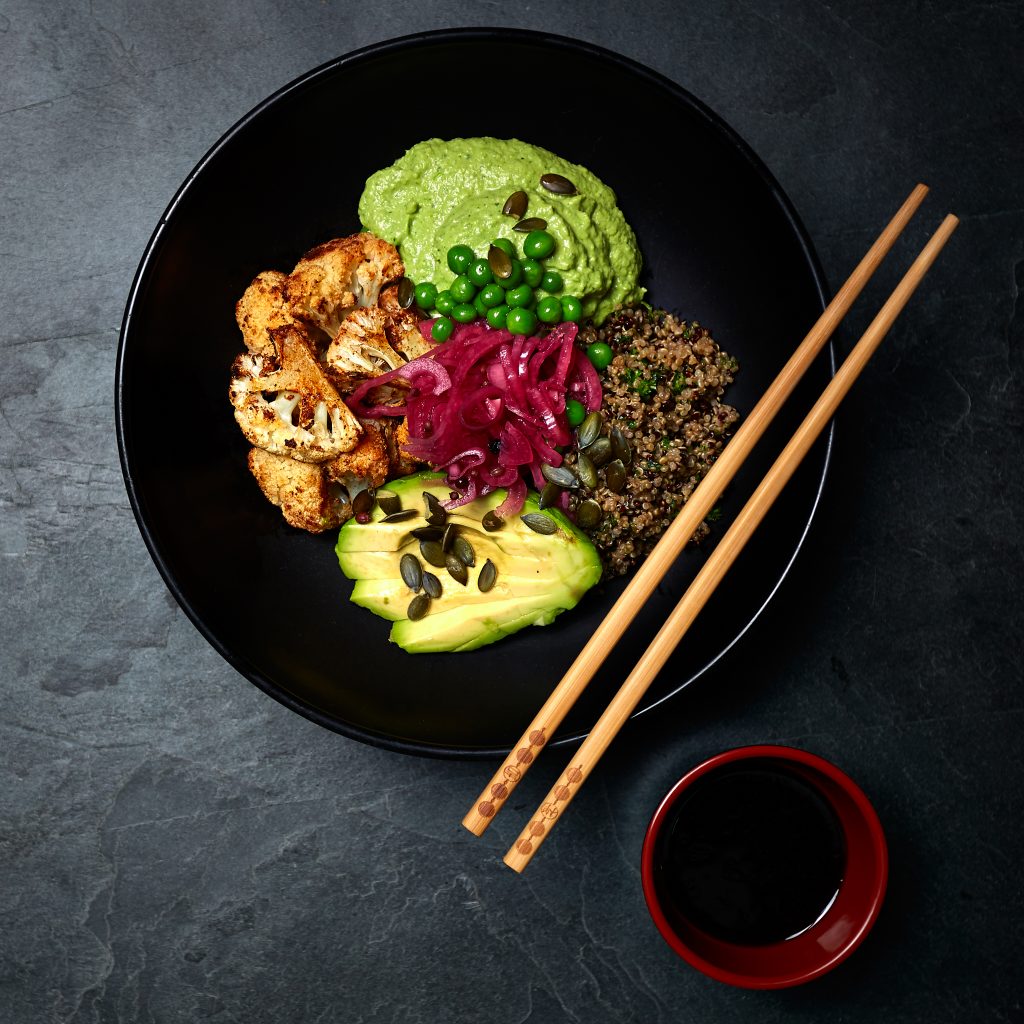Nothing says ‘new year, new me’ like adopting a healthier, plant-based diet, and January is the perfect time to do just that! Going completely cold turkey on eating meat (pun intended) can be very overwhelming and difficult for a lot of people, but having a bank of delicious and nutritious recipes on hand makes things so much easier.
We’ve done all the hard work for you and collated some of our favourite vegan recipes that spotlight the humble pea – making the little green wonders the star of the show! By utilising your frozen vegetables to create delicious recipes, you’ll also be supporting the 700 hardworking British pea farmers across the UK who produce around 160,000 tonnes of frozen peas each year, and who get most of the peas from field to freezer in around 150 minutes.
Have a scroll and enjoy these ap-pea-tising dishes!
Pea Dal with Coconut Chutney

Ingredients:
500g frozen peas
3 cloves garlic, roughly chopped
2 cm piece of ginger, peeled and roughly chopped
2 green chillies, seeds in, roughly chopped
1 tsp sea salt
1 tsp black pepper
1 tbsp vegetable oil
2 tsp black mustard seeds
2 tsp cumin seeds
1 tsp ground turmeric
1 onion, finely chopped
400ml can coconut milk
6 curry leaves (optional)
2 tsp garam masala
Small handful chopped fresh coriander leaves, to serve
Coconut chutney, to serve
FOR THE COCONUT CHUTNEY
25g desiccated coconut
1 small red onion, finely chopped
1 garlic clove, crushed
1 tbsp white wine vinegar
1 tbsp tamarind paste
1 tbsp olive oil
3 tbsp of Greek yoghurt
Chopped coriander
Sea salt and black pepper
TO TEMPER THE DAL (OPTIONAL)
1 tbsp vegetable oil/ghee
2 dried red chillies
1 tsp cumin seeds
1 tsp coriander seeds
6 curry leaves
Method:
- To make the coconut chutney, mix all the ingredients in a bowl and leave to one side.
- Bring a pan of water to the boil, then add the peas an bring back to the boil. Remove from the heat, drain the peas and refresh under cold water.
- Place approximately one third of the peas into a blender with 150 ml cold water and process to a smooth purée. Put the remaining peas and the pea purée to one side.
- Finely chop the garlic, ginger, chillies. Add the salt and mix well.
- Heat the vegetable oil in a pan until hot. Add the mustard seeds, cumin seeds, garam marsala and turmeric. Fry, stirring constantly, for 30 seconds before adding the onion.
- Reduce the heat down and cook the onion with the spices for 4-5 minutes until they are soft and translucent, stirring frequently. Add the garlic, ginger and chilli mix.
- Cook for another 3 minutes, stirring frequently, and then add the coconut milk, the pea purée, and curry leaves (if using). Stir and reduce the heat to low.
- Bring to a simmer and cook for a further 10 minutes until the liquid has reduced, stirring occasionally. Add the remaining cooked peas and bring to a simmer.
- To temper the dal, add the oil to a frying pan on a low heat. Add the chillies, cumin and coriander until it crackles. Add curry leaves for ten seconds then remove and pour over the dal.
- Remove the dal from the heat and serve with the chopped coriander, flatbreads or rice and the chutney.
Thai Pea and Mushroom Larb with Toasted Rice

Serves 4
Total time 25 minutes
Categories: Vegan, Vegetarian, Gluten Free, Dairy Free, Healthy, Quick & Easy, Entertaining
Ingredients:
1 tbsp Jasmine rice
2 tbsp vegetable oil
300g shitake mushrooms, sliced
2 shallots, peeled and diced
3cm piece of ginger, peeled and finely grated
2 garlic cloves, crushed
1 tbsp sweet chilli sauce
2 red chillies, chopped
½ tbsp light soy sauce
300g frozen peas
4 spring onions, chopped
Handful of roughly chopped coriander
Handful of roughly chopped mint
Juice of 1 lime
TO SERVE:
Little Gem lettuce leaves
Sliced red chiLli
Coriander leaves
Jasmine rice
Method:
- In a dry wok or frying pan, toast the rice grains over a medium heat, stirring continuously until golden brown and fragrant which will take around 6-8 minutes. Grind the rice to a coarse powder in a pestle and mortar.
- Place the wok or frying pan back on the heat. Add the oil and fry the mushrooms until slightly browned, then add the shallots, ginger, garlic and stir-fry for a further 2 minutes. Then add half the rice powder, sweet chilli sauce, chillies, soy sauce, peas, half the spring onions, chopped coriander and mint leaves, lime juice and season with a little more lime juice and soy if necessary. Cook for a further minute.
- Put the pea and mushroom larb in Little Gem lettuce leaves. Top with extra chilli, coriander leaves, the remaining rice powder and spring onions and serve with some steamed Jasmine rice.
Buddha bowl

Ingredients:
1 small cauliflower, chopped into florets
2 tbsp of cold-pressed British rapeseed oil
2 tsp Baharat
Pinch sea salt flakes & freshly ground black pepper
100g quinoa, cooked
Juice of ½ a lemon
Small handful chopped parsley
1 avocado, peeled and sliced
Chopped fresh parsley, to serve
Pumpkin seeds, to serve
FOR THE PEA HUMMUS
300g frozen peas
3 tbsp tahini
3 tbsp lemon juice
½ tsp ground cumin
Small handful chopped fresh coriander
2 spring onions, trimmed and finely chopped
2 cloves garlic
FOR THE PICKLED ONIONS
150ml cider vinegar
1 ½ tbsp caster sugar
6 black peppercorns
6 coriander seeds
2 small red onions, sliced into rings
Method:
- Preheat the oven to 200°C/400°F/Gas mark 6.
- Drizzle the cauliflower florets with 1 tbsp of olive oil, sprinkle over the Baharat and season with salt and pepper. Spread the florets evenly over a baking sheet and roast in the oven for 20-25 minutes, tossing once or twice throughout.
- Mix the quinoa with the lemon juice, chopped parsley and a little olive oil.
- To make the hummus, cook the peas in a pan of salted boiling water, drain well and rinse under cold water. Blend the peas into a smooth purée in a food blender. Mix the crushed peas into the puree and stir in the tahini, lime juice, cumin, coriander and spring onions. Season with salt and pepper to taste.
- For the pickled red onions, pour the vinegar into a saucepan and add the sugar, some salt, the peppercorns and coriander seeds. Bring to simmering point and simmer until the salt and sugar have dissolved. Remove from the heat. Put the onion slices into a colander and pour over some boiling water. Drain well. When cool enough to handle, pack the onion rings into a sterilised jar, cover with the warm vinegar, seal and allow to pickle for 2 hours. Any leftover pickled onions keep well and can be used in future dishes.
- To assemble your bowls, start with a big scoop of quinoa, add in a large helping of spicy cauliflower and some diced avocado, some pea hummus and some pickled red onions.
- Top the whole bowl off with some chopped fresh parsley and pumpkin seeds and dig in!




